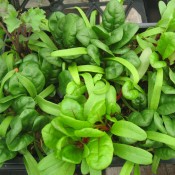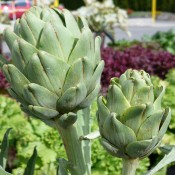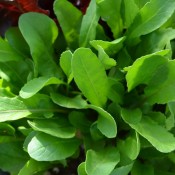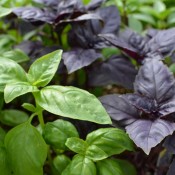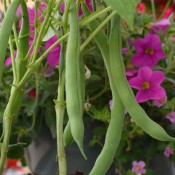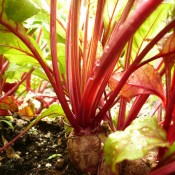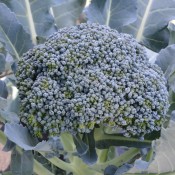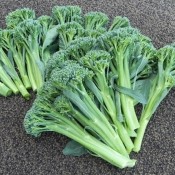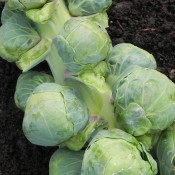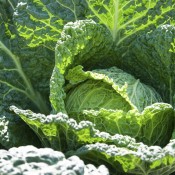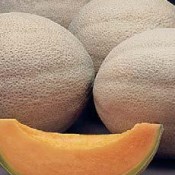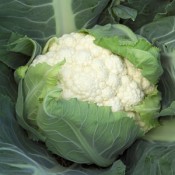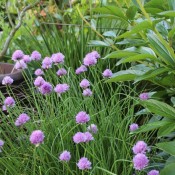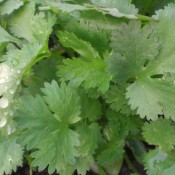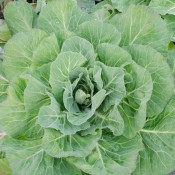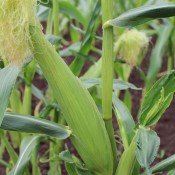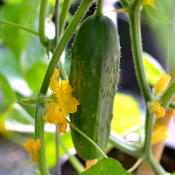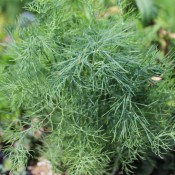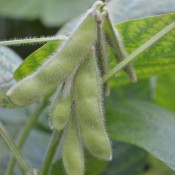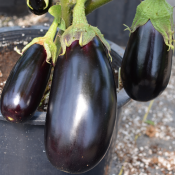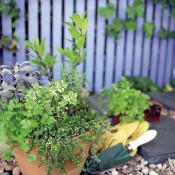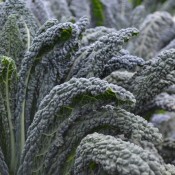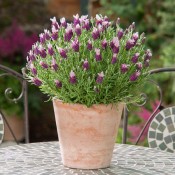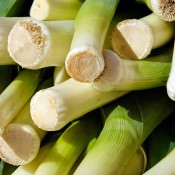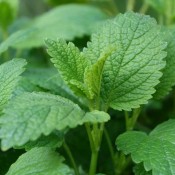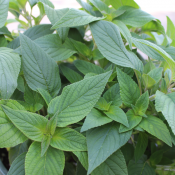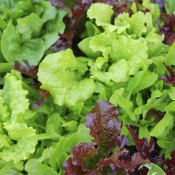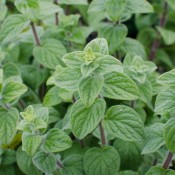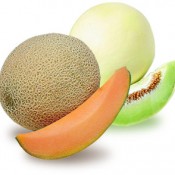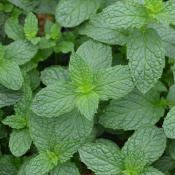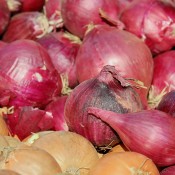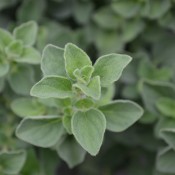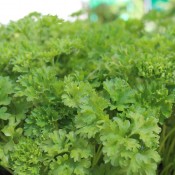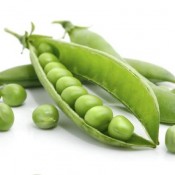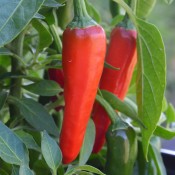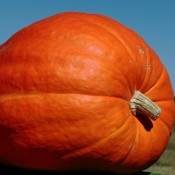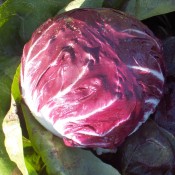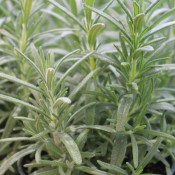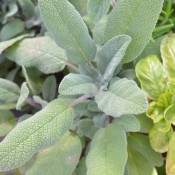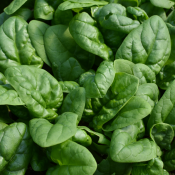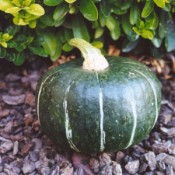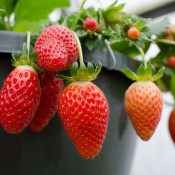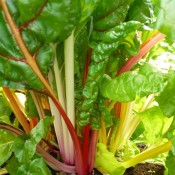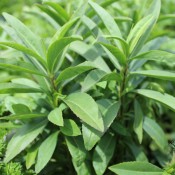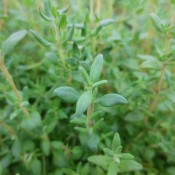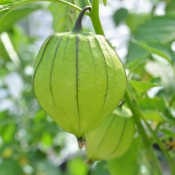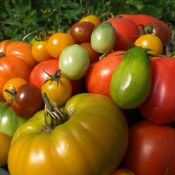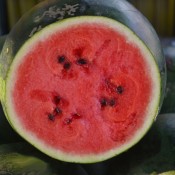Organic Edibles Plant Listing
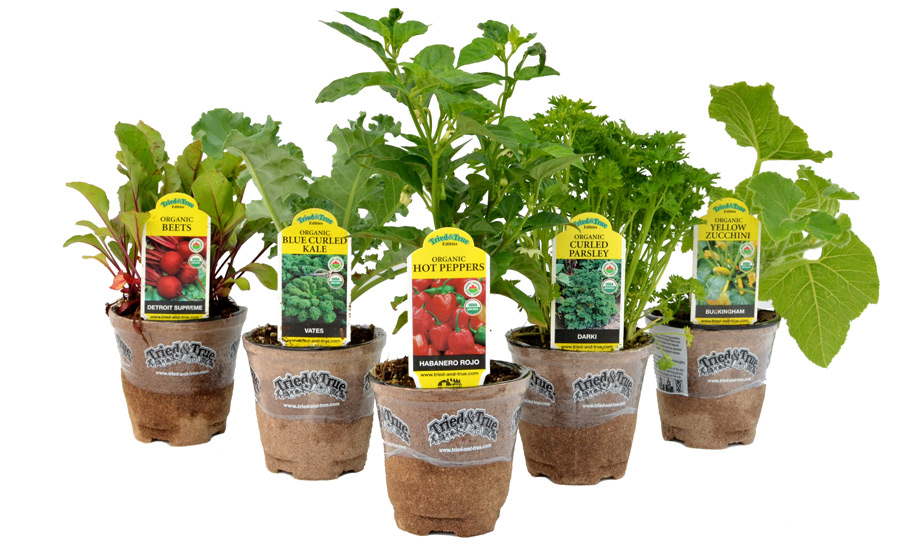
Tried & True is committed to the success of the home gardener by providing superior varieties while being kinder to the environment and reducing our carbon footprint. We recognize the importance of growing the food locally that we eat, meeting and surpassing the 100-mile challenge. Our farming roots run deep; we concentrate on varieties that will grow well, produce, look good and taste good. We know fresher is always better so what’s fresher than produce grown right in your backyard. From your backyard to your table, home-grown foods are rich in texture and flavour. The proof is in the taste. Get a head start with our with our garden-ready plants. We invite you to join our table.
What is better than produce grown in your backyard? Organic produce grown in your backyard. Many believe organic farming can lead the way in changing our food culture. Organically grown produce tastes better and is better for us and our environment. It is not a passing trend, but rather it is a lifestyle choice. In response, Tried & True Edibles is 100% certified organic. With our Organic Edibles, the consumer is rest assured by independent third party inspection that we use only approved products. We follow the strict guidelines and code of practice set down by the TransCanada Organic Certification Services. We have accreditation compliance with Canada Organic Regime (COR), USCOEA and USDA Organic. Not relying on synthetic chemicals and pesticides are the best ways we can be kinder to the earth, leaving less impact on our environment for future generations.

Edibles Care & Maintenance
Edibles FAQ
Steps Towards Sustainability
606 VARIETY PACKGet a jump on your spring veggie garden with 606 packs! Available at your favourite garden centre in early spring, six cold tolerant plants combine to form a fantastic assortment of delectable edibles in one pack, meaning your crop will be ready for early harvesting.
ARTICHOKECynara Scolymus Native to the Mediterranean, the artichoke has been cultivated since the days of the ancient Greeks and Romans. It was first introduced to California by Spanish explorers, later by Italian farmers who settled along the central California coast. Today, the majority of artichokes eaten in Canada and the United States are grown… Read more »
ARUGULAEruca sativa Native to the Mediterranean, arugula has been cultivated since the days of the ancient Romans. It was grown as an edible herb but is also mentioned by several classical authors as an aphrodisiac. For this reason, arugula was forbidden to grow in monasteries during the Middle Ages. Although introduced to the Americas by… Read more »
BASILOcimum basilica Basil is one of the most popular herbs in cuisine and gardening. It is admired for its flavour and aroma, as a companion plant in vegetable gardens, and for its lovely foliage colours in ornamental plantings. Native to the Middle East and Asia, basil has been cultivated for medicinal and culinary purposes for… Read more »
BEANSPhaseolus vulgaris Beans are a dietary staple throughout the world, grown in a multitude of varieties and eaten at various stages of maturity. Though they belong to many different plant species, they can be divided into two broad categories-edible pod beans and fresh-shelled beans. Beans are quite sensitive to cold temperatures and frost. They should… Read more »
BEETSBeta vulgaris Beets and their cousins all descended from the sea beet, a wild seashore plant grown throughout southern Europe, which has been eaten since prehistoric times. Beets have been used since ancient times for medicinal purposes. Today, it is newly appreciated for its anti-cancer properties and its cholesterol-lowering ability. Common beets are deep red… Read more »
BROCCOLIBrassica oleracea Italica Group. The modern world received broccoli from Italy, where it has been a favourite food since the days of the ancient Romans. For centuries, it was only known in the Mediterranean, but in the 1500s, it was introduced to France and about 1720 to England. It wasn’t until 1920 that a group… Read more »
BROKALIBrassica oleracea. Brokali is a unique hybrid that combines the tender stems and florets of broccoli with the ruffled leaves of kale. It is an excellent performer in colder temperatures. Tender texture and sweet taste.
BRUSSELS SPROUTSBrassica oleracea Gemmifera Group. Though Brussels sprouts were developed somewhere in Europe, it is not on record whether their place of origin was really Brussels. A relatively modern vegetable, this nutritious member of the cabbage family was first cultivated in the 1600s or 1700s and didn’t become widely known in this country until the 1920s…. Read more »
CABBAGEBrassica oleracea Capitata Group One of the oldest vegetables known, cabbage has been cultivated for at least 4000 years. The world of brassicas is bigger than just cabbage for coleslaw. The cabbage family includes broccoli, Brussels sprouts, cauliflower, collards, kale, and kohlrabi. Many varieties of cabbages have been introduced ranging from the sweet, beautiful Savoy… Read more »
CANTALOUPECitrullus lanatus. Cantaloupe, as they are known in North America, is named for the town of Cantalupo near Rome where they grew. In Europe, these melons are known as muskmelons or nutmeg melons and take their name from the Romans’ habit of sprinkling the fruit with powdered musk to enhance the flavour. They are the… Read more »
CAULIFLOWERBrassica oleracea Botrytis Group The word “cauliflower” comes from two Latin terms and literally means “cabbage flower”. It has been cultivated in Asia Minor and the Mediterranean for more than 2,000 years. Cauliflower is cool season crop and belongs to the cole crop family which includes broccoli, Brussels sprouts, cabbage, collards, kale, and kohlrabi. To some,… Read more »
CHIVESAllium schoenoprasum Chives grow well in containers or in gardens as a pretty border plant. They have tall, green, grasslike leaves with purple pom-pom flowers. Harvest continuously from early summer until frost. Finely chopped tops of this versatile kitchen herb add a delicious mild onion flavour to almost any recipe. Chives are great companion plants… Read more »
CILANTRO or CORIANDERCoriandrum sativum Cilantro or coriander is one the world’s oldest spices. Spanning from 5000 BC to modern times, it has been used medicinally and culinary around the world. In ancient times, countries such as China, India, Egypt, Greece, and Rome used it for both its seed and leaf. It is thought this aromatic herb made… Read more »
COLLARDSBrassica oleracea var. acephal Collard greens are a broad-leafed vegetable related to the broccoli, Brussels sprouts, and cabbage. They are a cool season vegetable that make them extremely attractive vegetables for temperate regions with mild winters. Although synonymous with cuisine of the American South, collards have a rich history throughout the world. Thought to be… Read more »
CORNZea mays Sweet corn is undoubtedly the most eagerly anticipated crop of the season. But, did you know that corn is not a vegetable? It is actually a grain native to the Americas. Aztecs, Mayan, Inca, and North American tribes cultivated corn (maize) for thousands of years before the Pilgrims arrived. Today, our sweet corn… Read more »
CUCUMBERCucumis sativus “Cool as a cucumber” is not just a catchy phrase-it has some basis in fact. A cucumber’s pulp temperature may be up 20° cooler than the outside air. Cucumbers are about 96 percent water. Because their skin holds in moisture like a jug, these vegetables have been used to quench thirst since ancient… Read more »
DILLAnethum graveolens Dill was known as a medicinal herb to the ancient Greeks and Romans and was mentioned in Egyptian writings some 5000 years ago. It is native to southern Russia, western Africa, and the Mediterranean region. It is the most important culinary herb in Scandinavia, as popular as parsley is in other parts of… Read more »
EDAMAMEGlycine max. Edible soybean, called Edamame in Japan and Mao Dou in China, is grown mainly to harvest the young green-shelled beans for vegetable uses, and not for the matured soybean crops. Most commonly served as an appetizer, the whole pod is steamed or boiled for 3 to 5 minutes until bright green. Then they… Read more »
EGGPLANTSolanum melongena. Eggplant, a native of India, is actually a pear-shaped berry and part of the so-called deadly nightshade family, which includes potatoes and tomatoes. And despite the mythology of their poisonous effects, eggplants, particularly their skins, contain high amounts of antioxidant phenolic compounds, cancer-fighting elements that eat up free-radical scavengers in the bloodstream. Thus,… Read more »
HERBSAdd a sprig of herb and familiar foods take on a new character. Fresh herbs add aromas and flavours, from subtle to pungent. The popularity of herbs is due to the fact that these culinary delights are easy to grow, yield prolifically in small spaces, and are just delicious. The range of herb gardens can… Read more »
KALEBrassica oleracea var. acephala. Kale is thought to be one of the first cultivated brassicas, some 2000 years ago. It was the most widely eaten green vegetable in much of Europe until the Middle Ages. Colewort, its wild ancestor, still grows along the coasts of western Europe. Kale has been particularly important in colder regions… Read more »
LAVENDERLavandula Lavender is an herb garden favourite grown for its calming scent, gray-green foliage and spikes of blue-violet flowers. They are so versatile and can work in a variety of applications, from formal English gardens, cottage gardens, vegetables and herb plantings and rock gardens. While many gardeners use lavender as a border plant, it can… Read more »
LEEKSAllium ampeloprasum or porrum Coveted for their subtle onion flavour, leeks are prized by gourmets and food lovers. They look more like their kin, the lily, than its cousins, onion, and garlic. Leeks have a long cylindrical stem made up of concentric layers of overlapping leaves. Leeks can be used in a variety of ways –… Read more »
LEMON BALMMelissa officinalis. Lemon Balm is an easy-to-grow herb with citrus lemon fragrance and a distinctive lemon minty flavour. The oval, toothed leaves look similar to mint and may be mistaken for it at first glance. Lemon Balm is easy to grow and spreads vigorously so some may want to grow the herb in containers. Use freshly chopped… Read more »
LEMON VERBENAAloysia citrodora Lemon Verbena is a tender perennial shrub grown for its intensely fragrant lemon scent. The long, pointed leaves are adorned by sprays of tiny white or purple flowers in the spring and summer months making it an attractive garden addition. This herb is a fast-growing plant so frequent pruning is essential to keep… Read more »
LETTUCE Lactuca sativa. The humble beginnings of lettuce began when it was first grown as a weed in the Mediterranean area. The early Romans, who treated lettuce as a luxury food, were intrigued by the milky juice or sap that exuded from the cut stem. In fact, the word lettuce derives from the Latin word lac,… Read more »
MARJORAMMarjorana hortensis A milder, sweeter version of oregano. Subtly coloured, Marjoram features soft green, oval-shaped leaves, and small pinkish-white flowers. Its delicate sweet yet slightly spicy flavour lends itself well to virtually any savoury dish. This low-growing Mediterranean native is an attractive groundcover or edging plant. It also performs well in containers. Marjoram is good at… Read more »
MELON Cucumis melo. Melons are members of the large family of gourds or pumpkins, which grow on trailing vines. There are thousands of varieties and range in size. Melons are considered to be a fruit, but are often used as a vegetable. The wild ancestors of this species seem… Read more »
MINTMentha Mints are strongly aromatic perennials prized for their medicinal purposes to treat stomach aches and chest pains. Their essential oils are used to formulate cold remedies and alleviate nausea. Mint is also a common component of cuisine in various cultures, providing a warm, refreshing flavour with a cool aftertaste. It is the perfect kitchen… Read more »
ONIONAllium cepa. Onions have been grown for centuries and are one of the oldest cultivated vegetables – for 5000 years or more. They remain just as popular today and are used in almost every type of cuisine from around the world. Onions belong in every garden whether large or small because they take up little… Read more »
OREGANOOriganum vulgare The intense aroma and unmistakable flavour of true oregano are invaluable for seasoning Italian dishes, roasted meat, and vegetables. This robust aromatic can be grown in an herb garden or in containers. Oregano needs both excellent drainage and good air circulation to thrive; moderate fertilizer is sufficient. This hardy perennial is a bushy… Read more »
PARSLEYPetroselinum crispum Parsley often is taken for granted, yet its sprigs are essential for perking up a bland dish, adding colour to a special meal, or dressing a glass of tomato juice. It is a key ingredient in bouquet garni and in fine herbs. Whether it is curled or flat-leafed, parsley is one of the… Read more »
PEASPisum sativum. Peas are one of the oldest cultivated vegetables. A team of archaeologists unearthed peas that dated to 9750 B.C. at Spirit Cave in Thailand. In ancient times, these legumes were generally dried and used in soups. In wasn’t until the 17th century that eating fresh peas became fashionable with the French people. Today,… Read more »
PEPPERSCapsicum annum. When Columbus discovered the New World, he was searching for precious black pepper. But what he brought back to Europe were green peppers – long, spicy vegetables. These New World peppers quickly caught on in Europe and then spread to Africa and Asia. Today, hundreds of pepper varieties are grown worldwide. Some are… Read more »
PUMPKINCucurbita pepo. Pumpkins evoke memories of the autumn season; whether placed in a fall or Thanksgiving display or carved into scary looking jack-o’-lanterns. This type of winter squash boasts more than decorative good looks, it can be baked in pies and bread and the seeds can be roasted for snacks. In the garden, pumpkins love… Read more »
RADICCHIOCichorium intybus. Radicchio came to prominence with the pasta craze. It is a wild Italian chicory, related to the root chicories, and is enjoyed for its slightly bitter leaves. Red heads with white accents make radicchio an eye-catching crop. Chioggia types form rounded heads. Treviso radicchio looks like romaine lettuce, but it has pink-to-red leaves…. Read more »
ROSEMARYRosemarinus officinalis A beautiful evergreen perennial shrub, rosemary has narrow, aromatic green leaves that are reminiscent of pine. It is used for seasoning meats, savoury dishes, roasted potatoes, and baking. It prefers light, sandy soil mixed with lime and a south-facing planting area. To protect plants from winterkill, trim back. This will encourage new branching… Read more »
SAGESalvia officinalis A kitchen gardener’s dream plant: useful, good-looking, and easy to maintain. This hardy annual is easy to grow, capable of withstanding conditions that are far from optimal. Beneficial insects love this plant. Sage has lovely, woolly, silvery-green fragrant leaves that provide a strong, balsamic flavour to a wide variety of dishes. Use fresh or… Read more »
SPINACHSpinacia oleracea. Spinach was first cultivated in Persia several thousands of years ago. It was brought to Europe by the Moors when they invaded Spain and presented to China as a gift from the King of Nepal in the seventh century. Today, California is a leading producer of spinach, growing about half of the fresh… Read more »
SQUASHCucurbita pepo. Squash was one of the oldest and most important food crops. People from Central America and Mexico not only ate squash, but they used the gourds to make water jugs, bowls, and ceremonial masks, and they wove the stringy fibers of some varieties into cloth. Squash come in many colours, shapes, sizes, and… Read more »
STRAWBERRIESFragaria x ananassa. Strawberries were prized in ancient times by the Romans for its medicinal uses. Today, the common garden strawberry is a hybrid of two species: the big and juicy Chilean strawberry crossed with a sweet red American species. Strawberries are actually a member of the rose family are not “technically” berries. They are… Read more »
SWISS CHARDBeta vulgaris. Chard was believed to have originated somewhere in the Mediterranean as it was known to the ancient Greeks and Romans. By the sixteenth century, several varieties were available. The word Swiss was used to distinguish chard from French spinach varieties by nineteenth-century seed catalogue publishers. Swiss chard, known as leaf beet and spinach… Read more »
TARRAGONArtemisia dracunculus Tarragon is an excellent addition to any vegetable patch or container. The tall, slender branched stems hold glossy green lanceolate leaves that have a refreshing peppery flavour. Wonderful in a wide variety of dishes and sauces.
THYMEThymus vulgaris Thyme grows trouble-free in an herb garden, along a pathway, or in a container. A garden bed needs no special preparation before planting thyme as it grows well in average soil. Thyme grows to a low bushy mound of small, dark green leaves with attractive pink to purple flowers in midsummer. Thyme is… Read more »
TOMATILLOPhysalis philadelphica or Physalis ixocarpa. Also known as Mexican husk tomatoes or Mexican ground cherries. Tomatillos are native to Mexico and Central America where the Aztecs first cultivated them as early as 800 BC. They are actually classified as a berry because they have many tiny seeds, but in the culinary world, they are generally used as… Read more »
TOMATOLycopersicon esculentum. It took nearly four hundred years for much of the Western world to overcome its fear of tomatoes. The Spanish conquistadores brought the New World fruit to Europe and reported that the Aztecs and Incas ate tomatoes regularly with no ill effect but, early Europeans greeted the American fruit with distrust because botanically… Read more »
WATERMELONCitrullus lanatus It is thought that watermelon originated in the Kalahari Desert of Africa. The first recorded watermelon harvest occurred nearly 5,000 years ago in Egypt. Sometimes, they were placed in the burial tombs of kings to nourish them in the afterlife. From there, watermelons spread throughout countries along the Mediterranean Sea by way of… Read more »



